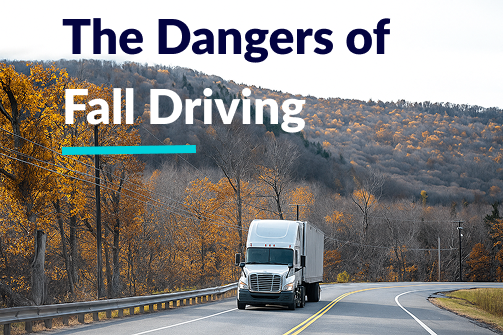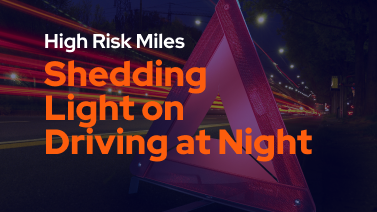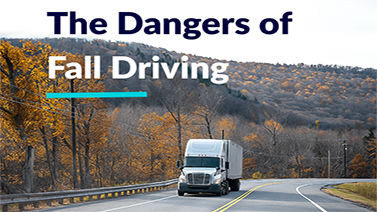The dangers of fall driving

As autumn settles in, truck drivers face a new set of seasonal challenges on the road. From changing weather to shorter daylight hours, it’s important to make sure your fleet is prepared. Here are 5 key fall driving hazards to watch for and tips to keep your drivers safe.
Hazard #1: School Traffic
The weather is getting cooler and football season is here, which means school is back in session across the country. Whether you have drivers that operate in local suburbs or operate along rural highways, they need to constantly be scanning for the following:
- School buses
- Kids at bus stops
- School Zones: Reduced speed limits, increased traffic, crossing guards, and parents picking up or dropping off children
Safety Tips:
- Slow down and look out!
- Increase your following distance behind school buses and be prepared for frequent stops.
- Remember that young children can be unpredictable, so drive with extreme caution when children are nearby.
Hazard #2: Wet Leaves
The vibrant colors of changing leaves may look beautiful, but they can pose a serious risk as fallen leaves begin to accumulate. While dry leaves on the road can reduce traction, wet leaves are especially dangerous as they increase the risk of hydroplaning.
Safety Tips:
- Slow down!
- Avoid sudden braking and swerving.
- Increase your following distance.
- Be especially careful when turning.
- Never, ever drive over or through a pile of leaves as they may be hiding debris or potholes. Piles of leaves can also attract children to play in or hide, so pay particular attention in residential areas.
Hazard #3: Deer & Other Animals
There are more deer-related vehicle accidents in the fall than at any other time of year. As it’s mating season, deer are more active between October and December with November being the most dangerous month.
Safety Tips:
- Pay attention to deer crossing signs and check both sides of the road when driving in wooded areas, scanning every 6-8 seconds.
- Remember that deer travel in herds – when you see one there are likely others nearby.
- Reduce your speed at dawn and dusk as these are the times when deer are most active.
- Don’t veer if a deer crosses the path of your truck; brake firmly and try to stay in your lane.
Hazard #4: Sun Glare
Although it sounds a bit strange, sun glare is actually worse in the fall. The sun is moving closer to the horizon and getting lower in the sky, making it more difficult to see.
Safety Tips:
- Wear polarized sunglasses to protect your eyes and help manage the glare.
- Keep your windshield free of dirt, dust, streaks and scratches – both inside and out.
- Use your sun visor.
- Avoid washing and waxing products that increase the shine on your truck. These products can magnify the glare and cause it to reflect into your eyes.
- Sun glare is worse in early morning and late afternoon, so try to avoid driving at those times if possible. If you can’t see, it’s best to pull over until visibility has improved!
Hazard #5: Fog and Icing
The cool fall mornings may be a relief after a long, hot summer, but the lower temperatures mean fog is more likely to form. While fog can hamper visibility, it can also lead to icing if it drifts down over roads that have cooled below freezing temperatures. In this scenario, thick coats of ice can form in just a few minutes.
Safety Tips:
- Use your low-beam headlights in foggy weather. High-beam headlights bounce off fog and reflect back at you, further impairing your ability to see the road.
- Reduce your speed and leave plenty of following distance.
- Be especially alert in the early mornings and during the night when temperatures are at their lowest. This is when you are most likely to encounter black ice. Higher elevation areas are also more prone to fog and ice during this time of the year.
- Pre-Trip Planning is critical – Make sure your drivers are prepared for different weather conditions as they travel through different regions of the country. Chain laws are also starting to go into effect, so check state laws and re-train drivers on chain usage.
Editor’s Note: This post was originally published in October 2022 but has been updated for accuracy and comprehensiveness.


